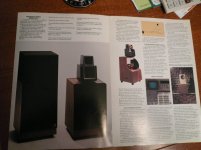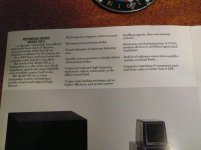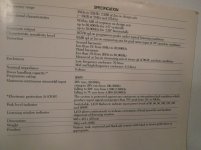Obviously you are not understanding.
Lets say a driver weighs 2kg and the cone mass is 15g. That is a 0.015/2 = 0.0075.
Lets say a driver & box weighs 20kg and the cone mass is 15g. That is a 0.015/20 = 0.00075.
Numbers PFA.
I can hear that difference. And i have often seen anecdotal reports of others hearing the same. All the details need to be right.
dave
The problem is not the cabinet moving back and forth, it's that the panels in the cabinet have a resonant character due to the fact that they are flat and edge-pinned. Inject a small amount of vibrational energy into them and they ring. That is a completely different phenomenon than induced movement along the axis of the driver...
So, when you decouple the source of energy (the driver) from the resonator (the cabinet) these resonances go away.
The relative movemrnt of the 2 parts is noise.
dave
No, the center of mass of the driver (if freely suspended) will move linearly WRT the input signal. This is NOT distortion or "smearing of detail".
You must have a very narrow definition of noise.
Your other question has already been answered.
dave
Your other question has already been answered.
dave
Inject a small amount of vibrational energy into them and they ring.
A properly designed cabinet will rarely if ever get sufficient energy at the right frequencies for long enuff to excite the (potential) resonances in a panel.
But there are many, many crappy boxes out there and as the OP expresses decoupling in his crappy boxes helps.
dave
If that is directed at me, there is a well understood definition of noise and that's the one I'm using, it thus follows that your answer does not make sense.You must have a very narrow definition of noise.
Your other question has already been answered.
dave
The relative movemrnt of the 2 parts is noise.
dave
And what is that definition?
dave
Noise is generally understood to be an uncorrelated signal.
I have to agree with scottjoplin on this one. Decoupling does not create a source of "noise".
OK, let’s call it loss of information then, i use “noise” as a term for the mechanism of that loss. It makes sense in the greater context my mathematical background has brought.
dave
dave
OK, let’s call it loss of information then, i use “noise” as a term for the mechanism of that loss. It makes sense in the greater context my mathematical background has brought.
dave
If the "loss" is linear and less than 1dB, then where is information lost? From the lowest 1dB of perceptable sound information? That would be down in the noise floor of the listening space. But the ear is not like a digital system - it has very high resolution. So I think nothing is really lost in fact.
But even if there is a "loss", if so I will take that and in exchange I get to remove any cabinet noise. Wouldn't cabinet noise similarly mask these low level details you are saying would be "lost"?
Anyway, these potential problems is why I build my systems with decoupled drivers and mostly without baffles. It makes these problems moot. No cabinet resonances, no re-radiation through the cone, etc. Just pure driver energy coupled into the air.
Last edited:
I have consistently found that given a decent cabinet, the downsides of decoupling the driver far outweigh the upside.
I started playing with this when we short circuited the gaskets in the, then new, KEF 105 midranges to make large gains in midrange DDR.
Since no information is lost and in this regard there isn't a downside to decoupling, a possible explanation for your preference is amplification due to cabinet resonances.
But even if there is a "loss", if so I will take that and in exchange I get to remove any cabinet noise. Wouldn't cabinet noise similarly mask these low level details you are saying would be "lost"?
But (most) of the cabinets here do not have cabinet noise issues.
The increase in information we look for in our designs is compromised by lossy driver attachment.
Are you rear-mounted exoskeletons lossy?
no re-radiation through the cone, etc. Just pure driver energy coupled into the air.
No, just a very quick trip from the driver’s back to the front with all the compromises that entails.
dave
You've yet to explain how, I'm interested to know, I've not been able to find an explanation for this anywhere. Do you mean "increase in" or "no loss of"?The increase in information we look for in our designs is compromised by lossy driver attachment.
Okay, here is the brochure for my 105 series 2. So the drivers are isolastically decoupled from the cabs. The bass driver with 3 floating rubber mounts keeping the basket 1/8" in front of the cab coupled to the cab with a soft foam gasket which is attached only to the basket. It simply rests against the cab. The mid is mounted with rubber grommets and the encased tweeter/housing on a foam pad. I can tell you from experience they are superb.
Attachments
Last edited:
Do you mean "increase in" or "no loss of"?
All systems have some loss of information, i mean that we aim to maximize the information a speaker is capable of revealing without being masked (by things like box “noise", "cone noise”) therefore beng more capable of information transmission. Inormation has to bepresent on the SW first and not lost by the source or electronics the signs goes thru before making it to the speakers.
This results in greater amounts of subtle information that leads to more flesh on a voice, more ability to discern differences in instruments, for a better and more 3D soundstage/image. The brain has to work less hard to replace the missing information, the listener can relax more and get closer to the music.
dave
The mid is mounted with rubber grommets...
Those were the ones we removed with good effect.
I was never all that impressed with the 105. A technical marvel at the time, but sonically did not live up to that.
dave
I bought them new in '78. Feed back reviews floating around were that the series 1 were better without the rubber mounts. I have not heard those but if there is a difference it couldn't be any more than subtle. The speed and immediacy of the bass driver is astonishing. I have a Charlie Byrd direct to disc jazz recording probably everybody knows about. Anytime I played it the only response I got were expressions as if they'd seen a ghost, silence, and then..@#$%^&* it sounds like they're right there. And it does, and not just the bottom end. However I will admit the louder they got the better they sounded. Best at 100db
Maybe subtle, maybe not, if the mounts were the only difference then it would be down to cabinet resonances. As far as I've been able to discover so far, other than the spl difference, which would be tiny, the only other thing that would change due to chassis movement would be frequency/phase and that would be negligible.Feed back reviews floating around were that the series 1 were better without the rubber mounts. I have not heard those but if there is a difference it couldn't be any more than subtle.
- Home
- Loudspeakers
- Full Range
- Softly coupling a driver to the cabinet



